I’m a bit of a dreamer. I’m also a huge aviation geek, and I often catch myself browsing the web at 2am looking up articles on aviation and aviation history. So when I found Anthony Toth and learned more about his life’s work, I knew that I had my next personal photography project in mind. As I'm mostly an architectural photographer, I got bored of waiting around for an airline to hire me to photograph their next ad campaign, so I decided to hire myself into my dream gig.
Over the course of three days of scouting, two days of shooting, endless phone calls and organizational headaches, I managed to put together my dream shoot. Here's how I did it in both video and text form. For an in-depth behind the scenes look, check out the video and read the text. Finished photos can be seen at the bottom of the post or by going to my website.
About Anthony Toth's Pan Am 747
I am not exactly sure how I first learned about Anthony Toth and his project, to be honest, but I can remember my reactions to seeing what he’d done. Awe, disbelief, and utter respect were just a few. Anthony had, over the course of 30 or so years, restored the cabin of a Pan-Am 747-200 to exactly the way it would have been in the 1970s. No detail was overlooked, from the working lavatory lights and galleys to the working overhead bins, the original ashtrays, peanut packages, and cutlery. Stepping into Anthony’s creation can be a bit disconcerting - the detail is so incredible that you quickly begin to believe that you are actually in a plane, 30,000 feet above the ocean. Stepping out after spending a few hours in it feels like arriving at a new destination, and to not walk out onto the jetway you expect to be there, is, well, quite bizarre at first.
Anthony himself, as you would expect, is probably the biggest aviation geek you’ll ever meet, a badge he wears proudly. Ever since he was a little kid and would fly Pan Am to see relatives, he would collect souvenirs from every flight he took. Matchbooks, magazines, seatback safety cards, and on and on. He would record the audio of a flight with a handheld recorder, and play it back over and over again. He didn’t know it at the time, but this collection would grow into one of the largest aviation-related prop houses in the world.

As his collection grew, Toth realized that he had needed to start putting it all together. He began making calls to Southern California’s renowned aircraft boneyards, where retired planes are stored before being sold for scrap. Over time, he began to amass what would be the first iteration of his homegrown 747. Taking trips in a Honda CRV, he would travel all over California finding the pieces he needed: a seat there, a galley cart there, an overhead bin. Using his garage, he began to re-assemble the first class cabin of a Pan-Am 747, recreating the experiences he had as a child.
His first version of the project garnered him plenty of media attention and interest from the public - but he knew it wasn’t perfect. Toth wanted the entire experience, and his garage wasn’t letting him build out the plane the way he wanted. A few years ago, he decided to move his entire setup to a new location in East Los Angeles. Over the course of two years, Toth disassembled and re-assembled his entire cabin, building a support structure in the new warehouse to support the upper deck, a version of coach class, and the original first class. Hiring contractors and Hollywood prop specialists to put the plane together piece by piece, the project began to take shape, and his Pan Am 747 came to life.
As a result of his project, Toth became a sort of legend in the aviation world. He regularly hosts dinners in the cabin, inviting guests to fly the friendly skies, complete with original Pan Am flight attendants serving the exact same meals that Pan Am served, catered by the same company that originally made them. The flight doesn’t miss and details: Toth’s recordings of the Pan Am experience are piped in through a built in sound system, so you hear everything from engine spool up to flaps retracting and landing gear doors closing. Caviar and vodka is served as an appetizer, and guests are led to the upper deck dining room for dinner, just like in the old days.
He’s hosted television shows, worked as an advisor to television shows, and provides props for shows and movies. When the recent drama ‘Pan Am’ was released, it was Toth who was called to be the expert on everything from the way the flight attendants interacted in the cabin to the way the ticketing system worked. He did the same for Mad Men, and has supplied props for countless productions.
About the shoot
And yet, despite all this, there was no evidence that the location had ever been used for a photoshoot depicting the glory days of aviation. There had been plenty of marketing and editorial pieces shot in the cabin, which was mostly used for creating a smokey, sexy type of scene (Playboy, among others, have become regular clients of Toth’s). I took a few minutes to let my brain run wild, and tracked down an email address so that I could send Toth my ideas. I told him who I was, what I did, and how as an interiors and architecture photographer, I wanted to shoot and document his project. Seemingly a little skeptical at first, he agreed to meet up for lunch and to discuss some ideas. After our brainstorming session, we realized that we had a huge project on our hands. We wanted to get Pan Am flying again, if it was only captured by our cameras for a brief instant.
My mind began to turn with ideas. How were we going to shoot it? Who was going to model? How would I light it? There were tons and tons of logistical and organizational hurdles. Being an architectural photographer, I don’t usually work with models, and when I do it’s only a couple people at most. We wanted to fill an entire plane with people and give them direction on what to do and how to pose. I also knew were were going to have to light this thing, but how? And how did I want the photos to look? The final look that we had in mind would determine everything from how we lit it to how the people dressed.
Scouting
The more I thought about the shoot, the more exciting the whole thing seemed. And at the same time, the more I realized that I had to come up with a lot of solutions to challenges I hadn’t worked through before. I visited the location a number of time leading up to the shoot, becoming more and more enamored with Anthony and the plane he had built every time. Both Anthony and myself agreed that we wanted this to be as authentic as possible in every way, so the lighting and staging had to look real. I played with a number of potential lighting setups and ran through a variety of compositional possibilities before making a final decision. Knowing how I’d light and shoot it would be immensely helpful when I went to plan out how many models I’d need, where they’d be, and how they’d be posed in each shot.
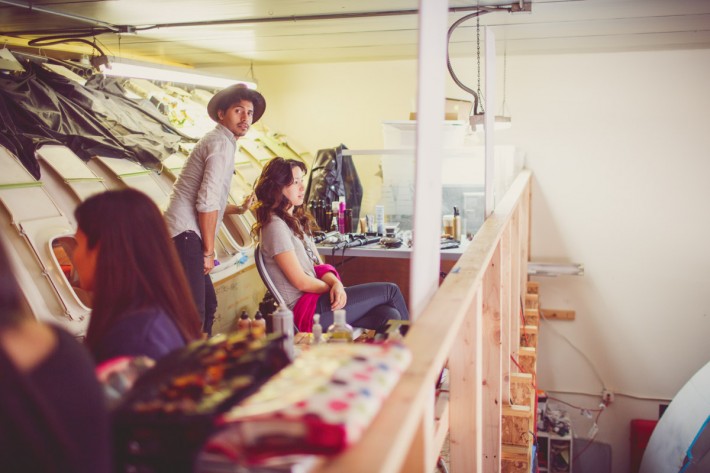
Which, of course, led to the next issue: finding the people who would act as models. Like I said, being an architectural photographer, I don’t have the biggest network of models in my rolodex, so Anthony and I had to improvise. We called on a number of friends who had an interest in aviation, and who would love to be a part of getting Pan Am off the ground again. This made for a great mix of models - young and old, with a range of personalities. Once we had the models lines up, we had to figure out how to dress them in attire true to the period. Each model had a meeting with a wardrobe stylist, hair stylist, and makeup artist to be touched up and get into costume. The flight attendants wore original Pan Am outfits that- you guessed it - Anthony had collected over the years. They were each authentic, and worn by an original stewardess - some of them even had the names and home base still written on them of the person who wore them.
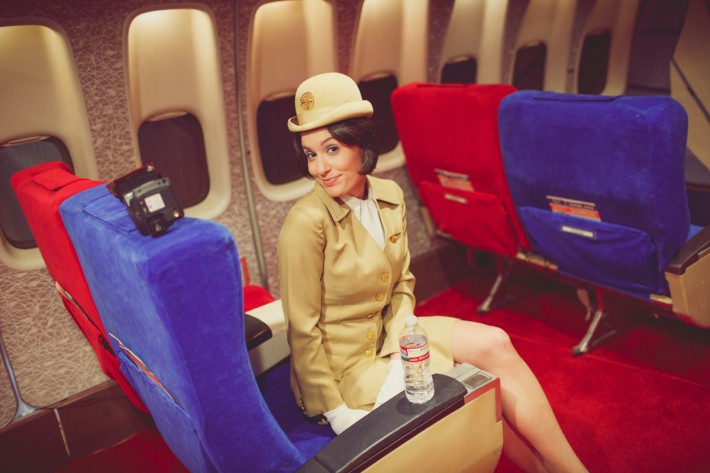
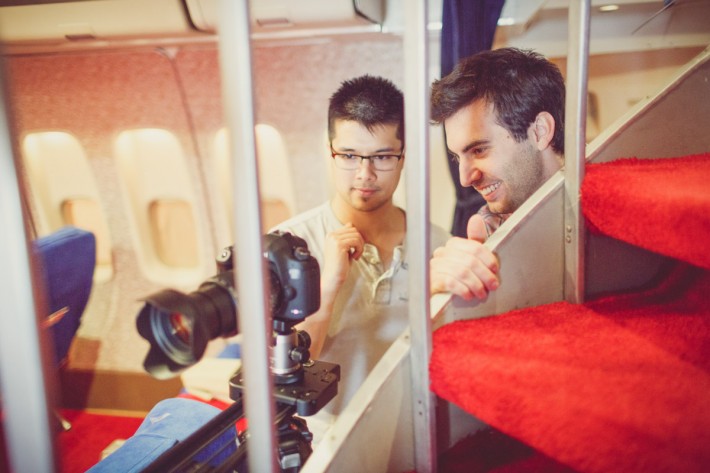
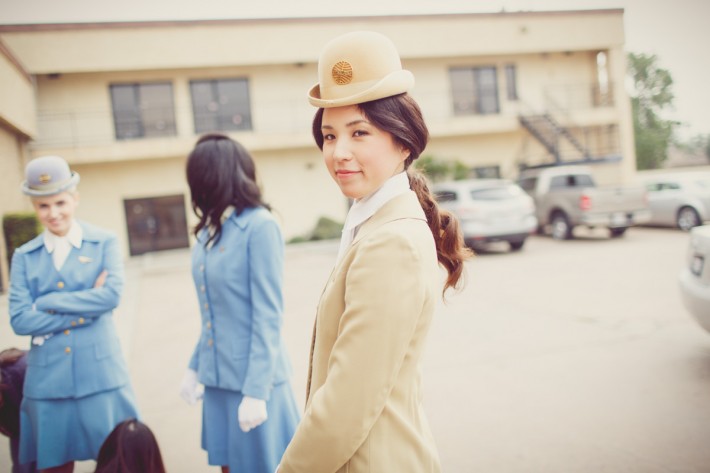
Once we had the models in place, the next matter became filling out the cabin with the touches that would make it 100% authentic. We decided on re-creating the entire Pan Am dining experience, plated as it would have been in Pan Am’s heyday and delivered to the passengers by the flight attendants still fresh and hot. Using Anthony’s contacts, we hired the Flying Food Group, a company that provides food for long-haul air travel, who catered it in (seriously) one of those scissors trucks that you see on the ramp whenever you fly. Absolutely too cool! We gave them a menu ahead of time and had the entire thing ready to order: from the Russian black sea sturgeon caviar to the Finlandia vodka, a full appetizer of tomato and mozzarella, the hot medium-rare roast garnished in front of the passengers, and a full dessert menu including a variety of hot and cold cakes and drinks.

Which introduced (yet another) hurdle to overcome: not only was I dealing with shooting an interior, a hard task in and of itself, but an interior filled with 20-odd passengers, all posed and dressed, and on top of that, we had to make the food look appetizing in photos, which is no simple feat. Making three types of photography happen at once in a cramped airplane cabin was an enormous juggling act - the timing had to be impeccable, and we were running an incredibly tight shot schedule consisting of 15 photos for the day.
Day One
On the weekend of the shoot, it came to light that my (admittedly, obsessive) planning paid off big time. We (myself, five assistants, and Anthony) spent the first day of our two-day shoot taking pictures of the empty cabin itself - mostly for documentation purposes, treating it as if it were any architectural or interior photoshoot. We staged props, dressed the scene, and made sure that everything was in line for day two, when all of our models showed up and mass chaos would surely ensue. While the shots seem relatively straightforward and simple - they were anything but. Our first shot, a wide interior of the first class cabin looking towards the nose from the galley area, took a staggering four hours of setup time. Being a fairly old airframe (the plane that Anthony owns is actually a 40-or-so year old Boeing 747-200 SP) it had plenty of areas which weren’t light tight, imperfections, and plenty of problem spots to deal with. Making this cabin look new again definitely took some TLC in a photographic sense. Scrimming and lighting it involved draping massive amounts of black cloth all throughout the plane, and even though it isn’t visible, it is doing its best to suck up and control all the light we were pumping into it.
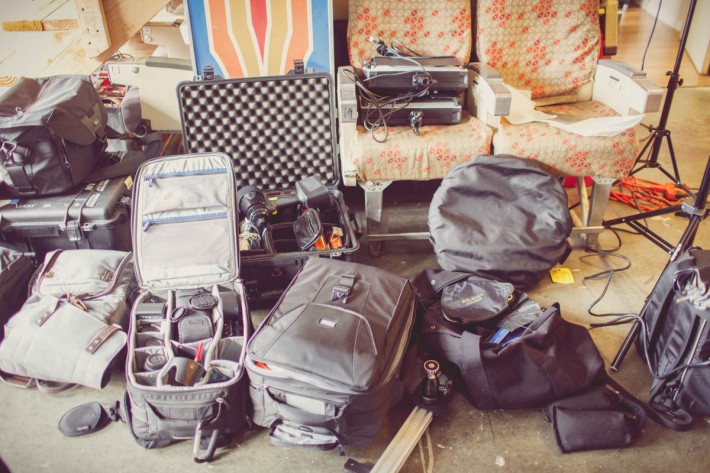
It took about 8,000 watts of light in total to light this thing up - and that only got me to around f8 at ISO 400. Because of the narrow passageways surrounding the ‘fuselage’ there wasn’t much room to aim the lights and control the falloff, so bouncing the light into those cavernous areas and letting it filter softly through the windows was the way to go. Bouncing it, of course, ate up the power like crazy. If we had aimed those lights in, we’d have a very hard, directional light, but it wouldn’t have been very lifelike. Everything here was working against us - the narrow spaces around the plane, the dark interior, and the tiny windows that we had to blast light in, but when all was said and done, it was a pretty simple lighting setup - just emulating the sun, blasting light in through the windows, just like it would look at 35,000 feet above the ocean.
As I mentioned, we used most of day one to choose our final compositions, get the lighting set, and deal with any issues that would arise on day two, when we’d be dealing with 20-odd models and a huge crew. The lighting setup remained pretty similar for all the shots, so once we had it dialed it was only a matter of small adjustments from image to image.
Day Two
After a long first day of shooting the interiors, we arrived bright and early to the location on day two and got ready to take care of the models who would be trickling in throughout the morning to have their hair, clothing, and makeup done. It was nothing short of chaos, to be honest, but by some miracle we got everyone looking absolutely amazing and in costume. This was no small feat, and the artists did a fantastic job of dressing and styling everyone in only a few short hours. I walked around and got to know everyone, and started getting the lighting dialed in so that there’d be no delay as soon as all the models were ready. After a quick (unplanned, and most likely horrible) speech, it was go time, and we got to work telling the story of Pan Am flight 120 from Los Angeles to London.
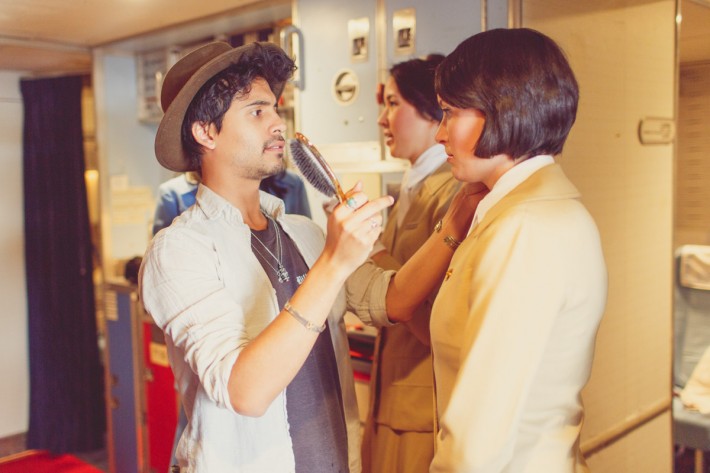

The cabin was prepared by the stewardesses, headphones were laid out, and the drinks began being poured. Passengers were ushered in, posed, and generally left to mingle but gently directed into poses that would read as casual yet proper and, well, first-class. After everyone had settled into the mood of things and got used to the rhythm of the shoot, we started heaping on the complicated bits. The food service was prepared a few hours after it was dropped off up by Jaron Schneider, an assistant and good friend of mine, and prepared to look as appetizing as possible. Even for airline food, it looked damn good! Our stewardesses played it right in front of the passengers: caviar and a perfectly cooked roast, along with all the aforementioned goodies were carefully styled, posed and shot. My mouth is watering even thinking about how good the food was, and how good it must have been back when this was a regular occurrence in first class. Getting everyone in place and the food looking good of course proved to be a challenge, but thanks in large part to the posing help offered by my assistants Julia Kuzmenko-McKim and Sarah Williams, things were ironed over relatively quickly. After our wide interior shots and tight detail shots downstairs, we went up to catch the post-dinner lounge action.
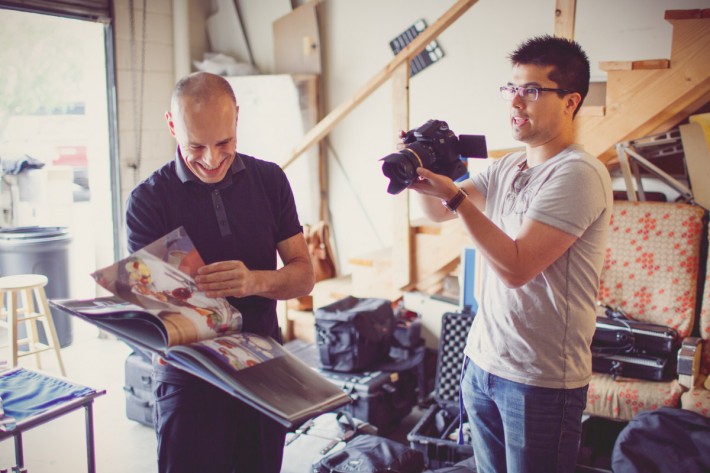
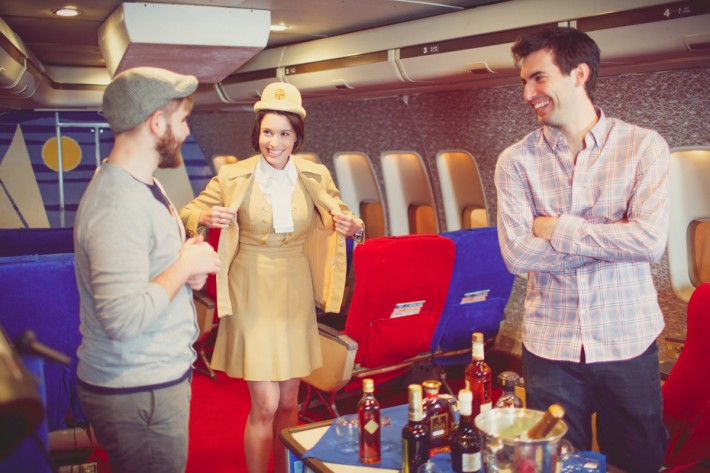
Changing our lighting from a bright white sunlight to a directional golden sunlight helped set the mood for the smokey upper deck lounge, where passengers often smoked cigars, drank fine liquors and played cards and mingled during flights. Of course, this seems like an enormous waste of money for the airlines now, but back then it was all the rage and many airlines actively promoted the amenities that their upper deck lounges featured. Shooting up here proved to be a monumental challenge - as most of the crew couldn’t even stand up straight without banging their heads on the ceiling or walls. Many of the lights were burnt out due to old age - so we had to improvise lighting to re-create the mood and ambience that would have been present in these lounges. This, again, proved to be problematic - the homemade lighting solutions we employed required us to shoot at high ISO speeds - up to 1600 - to capture the models without motion blur and the glow from the lights simultaneously. Even at ISO 1600, a shutter speed of 1/5th of a second was needed to get enough light into the lens. This was without a doubt one of the most challenging conditions I’ve ever shot in. The pictures don’t really tell the full story of the tight quarters, the soaring temperatures, and the mental toll that two twelve hour days of shooting inflicted on us. Despite all this, these shots are some of my favorite from the entire shoot.
Lastly - after the smoke has cleared and the upper lounge shut down for the night - the passengers retreated downstairs and settled in for the feature film that would have been shown on the drop-down screen at the front of the first class cabin. Employing a combination of long exposure and light painting techniques, we brought the cabin to life to appear as if it would in transoceanic flight at sunset - quiet, relaxed, and inviting. The passengers have settled in for the overnight leg of the trip and will pass the time through sleep or the movies until arriving bright and early in London the next morning.
Post Production
While the shots straight out of the camera were (in my not-so-humble opinion) spectacular, they needed a lot of love to get them looking the way we had envisioned. As I mentioned earlier, there were plenty of things that were easily overlooked in person, but rather obvious to the camera. Make no mistake that Anthony’s project is absolutely spectacular, but a 40 year old plane that has been in service flying around the world for decades shows a great deal of wear and tear. After it was retired from service, this particular plane sat in the Mojave desert at the Mojave Air and Space port, awaiting sale for scrap. The desert took a bit of a toll on the aircraft, and it had sat in a state of disuse until Anthony found it and brought it back to life. Most of the post production work involved cleaning up the interior lighting and walls, and making the plane look as new as possible. In a few cases, separate frames were merged with different model poses in order to create the best possible scene. Certain gestures and facial expressions were replaced with those from earlier frames, and Stewardesses were moved around to put them in the best positions. All of the wide shots are composites to some degree, some more than others. The most time intensive task was cleaning up, stretching, skewing, and otherwise tidying up an aircraft interior that had seen 30 years of service.
 Before lighting, processing, etc - moderately dreadful to the camera!
Before lighting, processing, etc - moderately dreadful to the camera!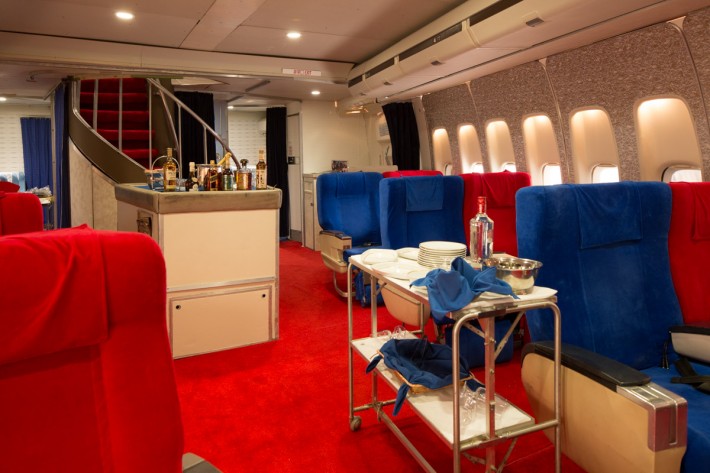
I opted to create a vintage feel to the photos - in order to bring them more in line with the aesthetic of the time. With the help of Tam Nguyen, I created custom curves and color tone presets in Photoshop and Lightroom that created a surreal, illustrative feel to the photographs. I really believe that this makes the entire shoot much more believable and tangible - it adds a little bit of imperfection back into an otherwise staged and clean series of photos.
 Before boarding, stewardesses prepare the forward cabin for arriving passengers. Magazines, headsets, blankets and pillows. There would typically be at least four flight attendants servicing the forward first class cabin.
Before boarding, stewardesses prepare the forward cabin for arriving passengers. Magazines, headsets, blankets and pillows. There would typically be at least four flight attendants servicing the forward first class cabin. 


 First class passengers are welcomed on board through a private jetway and led to their seats in the forward cabin.
First class passengers are welcomed on board through a private jetway and led to their seats in the forward cabin. After boarding, champagne and snacks are given to passengers eagerly awaiting their trips, and elegant gold-stamped menus featuring cuisine from around the world are distributed. Passengers begin to settle in with magazines, and luckier ones are, unbeknownst to them, given pieces of Pan Am history.
After boarding, champagne and snacks are given to passengers eagerly awaiting their trips, and elegant gold-stamped menus featuring cuisine from around the world are distributed. Passengers begin to settle in with magazines, and luckier ones are, unbeknownst to them, given pieces of Pan Am history.

 Once at cruise altitude, hot meals of the utmost quality are served. Often spanning multiple courses, everything from fine Russian caviar to fresh roasts and fresh-baked breads make the rounds. Alcohol flows without reservation, and desserts are absolutely decadent. It's as if a five star restaurant has taken to the skies. Even with someone in front of you at full recline, you'd be hard-pressed to worry about spilling wine: Pan Am's first class seats were designed to be roomy enough that you'd be able to walk around and eat even with those in front of you completely reclined and fast asleep.
Once at cruise altitude, hot meals of the utmost quality are served. Often spanning multiple courses, everything from fine Russian caviar to fresh roasts and fresh-baked breads make the rounds. Alcohol flows without reservation, and desserts are absolutely decadent. It's as if a five star restaurant has taken to the skies. Even with someone in front of you at full recline, you'd be hard-pressed to worry about spilling wine: Pan Am's first class seats were designed to be roomy enough that you'd be able to walk around and eat even with those in front of you completely reclined and fast asleep.


 In the back, it's a slightly different story. Pan Am's clipper class was the fore-runner to the modern day premium economy class. Even with slightly more legroom than coach, it's not quite as roomy as the first class cabin up front. Even as a premium economy class, the seats are significantly thinner and smaller than what we're accustomed to today.
In the back, it's a slightly different story. Pan Am's clipper class was the fore-runner to the modern day premium economy class. Even with slightly more legroom than coach, it's not quite as roomy as the first class cabin up front. Even as a premium economy class, the seats are significantly thinner and smaller than what we're accustomed to today. After dinner, passengers are free to roam around the plane. Many take to the upstairs lounge - a signature feature of Pan Am's 747 fleet - where they can relax with drinks, cigarettes, table games and enjoy conversations with fellow travelers while enjoying the view of the sun skipping across the horizon at 35,000 feet.
After dinner, passengers are free to roam around the plane. Many take to the upstairs lounge - a signature feature of Pan Am's 747 fleet - where they can relax with drinks, cigarettes, table games and enjoy conversations with fellow travelers while enjoying the view of the sun skipping across the horizon at 35,000 feet. 
 As the sun sets, passengers head back to their first class seats to settle in for the movie, shown on a projector screen in the nose of the plane. A far cry from the incredible in-flight entertainment systems of today, but at the time, cutting edge and second to none. After the movie ends, it's only five more hours to London.
As the sun sets, passengers head back to their first class seats to settle in for the movie, shown on a projector screen in the nose of the plane. A far cry from the incredible in-flight entertainment systems of today, but at the time, cutting edge and second to none. After the movie ends, it's only five more hours to London. That’s a wrap
When all was said and done, it took countless hours of planning, three scout days, two shoot days, over 20 models, six people on the photography and video side of things, three stylists, a full catering service, and a metric ton of lights to get this thing off the ground. Was it worth it? I absolutely think so. I don’t believe that photos similar to this will ever be created again - Anthony, myself, and the crew and models all came together to create something that pays tribute to an airline that sparked the imagination of countless people all over the world. It sounds cheesy, but I think if someone, whether an aviation enthusiast or not, can look at these photos and be inspired, relive their experience and remember what it was like to fly with Pan Am, or have a good laugh at all the changes in air travel over the last few decades, then the shoot was a success. I hope you enjoyed the article - I know I had one hell of a time getting this thing to happen, and hopefully my sharing it with you was interesting enough to warrant reading this far!
For those interested in learning the techniques used to create this image, I teach all of them (and more) in my comprehensive tutorial, Where Art Meets Architecture, which was published in collaboration with Fstoppers. In addition, I'll be teaching at the Atlantis Resort in June at the Fstoppers Workshops (and I'm also giving away an entirely free slot at one of my workshops!). Feel free to come on down and pick my brain about anything from architectural photography and airplane photography to being the biggest nerd the photo world's ever seen.






Good stuff as usual Mike!
Incredible work and a great video showing us the magic of how it was created.
Thanks Noam!
Wow, that was amazing! Awesome video and great work of course!
Thanks Keegan!
Incredible work! Fstoppers at your best! Bravo!
Outstanding.
Thanks, Scott!
Awesome!
Simply incredible Mike! I thoroughly appreciate a high-production shoot and it looks like you and your team pulled it off very well! Congrats on a successful shoot!
Thanks man!!!
Epic!!
Mike, this is truly inspirational! I am envious to be honest, but such a fan of your work and especially since you're reaching out to your passions, not only in photography, but in aviation and accomplishing it. I have to assist you one day, if ever you're in Europe - I would bend-over-backwards to be able to learn from you in person and actually, get to meet you and have a beer... absolutely awesome work!
Thanks, Shayne! Appreciate it...my life is all about following my passion and what I want to do, and it's worked out alright thus far. It's highly addictive though, beware.
Superb stuff Mike! Really inspiring and unique work. Creating a vision of style and customer service from a day gone by and which has changed so much. It reminds me of when I was much younger and was lucky enough to travel on Pan-Am and TWA airlines in first class. Really great, thanks for all the effort and for sharing it with us.
Airline prices in the US were regulated by the government until 1978.
You might think that being forced to charge $750 for a flight that would naturally be priced at $400 would result in $350 in extra profits.
But the airlines instead competed on amenities, and spent that extra money on luxurious experience.
So when you fondly recall the golden era of aviation, remember that it was an experience reserved for the elite few.
You can still experience something very similar today - but it's still reserved for the very wealthy. Some of the best airlines in the world (Emirates, Thai, Lufthansa, etc) still have what I'd consider to be 'better' products than what Pan Am was offering back in the day, but expect to pay through the nose for it. Coach is a different story entirely, though.
This is amazing! Great job done by all! Thank you to you, and to everyone who made it possible!
Thanks Maryann, glad you liked it.
Fstoppers, i've said it before and i'll say it again. THIS IS THE CONTENT PEOPLE COME TO YOUR SITE FOR. Obviously you can't pump one of these out a week and keep the quality up, why why must we wade through the absolute drivel that is "Amazon Customer Seems Awfully Excited for the Sigma 50mm" and "Photoshop Fail: Retouching Academy Creates Masterfully Hilarious Edits from a Random Request". People can go to buzzfeed to soak up that level of content-repostery, but it has no place on a formerly great website such as this. You're just alienating viewers. I want to keep coming to your site, but you really need to trim the fat and the hack writers.
Appreciate it! Though our site runs on views, and the views of those articles you reference are higher than the ones this article is getting. We target our articles based on what people like, and what people like gets more views.
I want to make more content like this, but it's difficult to rationalize the cost and effort when the view counts are 70% - 80% lower than those posts that you reference.
Great post. More of this please!
Thanks, Mark! Working on it :)
Those were some amazing shots in such an incredibly difficult space. I'm really wowed by the attention to detail. Really makes me wish PanAm was still around and that I could afford to fly in a cabin like this.
Thanks, Kyle! I'm right there with you...I would love to experience this!
As an ex-Pan Am Flight Attendant, it was so amazing to see a 747 Cabin
re-created so astonishingly realistic. It was like going back in time ,
and remembering what a great experience it was to work on a Pan Am 747
flight. Thanks so much to Anthony Toth for his beautiful mock- up
vision, and to Mike Kelley for the fantastic work on the photos and
video 'onboard' !!
Ahhh this is the best comment that could ever be left! Awesome to hear that you like it and we were able to give you a nice little trip down a somewhat accurate memory lane. I will pass on your kind words to Anthony!
This is legit the best post I've seen in a while. Good job you guys!
I loved this!! Absolutely loved this! Thank you for always posting such interesting content. This is the reason I come to Fstoppers!
Thank you! Glad you liked it!
Ahhh... Pan Am... I remember the days when the name evoked visions of far off lands and adventure.
Mike, these are incredible! I do a lot of work in the railroad industry and thought those spaces were tight! Very impressive lighting work.
I'm 6'6" and hate flying because of legroom nowadays, but these images have pushed past that strong negative association and make me want to fly!
boss, so damn minty
You forgot to mention one of the MOST unique things about Pan Am! The pilots all wore WHITE hats! It's one of the most famous signatures from a pilots point of view of Pan Am. When I was a kid I wanted to fly for Pan Am, so I could wear a white hat. But, alias, I wear a black one, just like everyone else!
I love the detail that you and others notice! I was pretty hung up on the Pan Am branded Sake.
Talk about high production values! Really curious to know what your budget was for this and how it was funded???? So daunting...
Hi Erika, thanks for the kind words, glad you liked it! The budget was, well, there was no budget that I had in mind, but it all came straight out of my pocket (except for the plane and props, which were all owned by Anthony). All I know is that I threw a lot of money at it. I imagine my accountant will figure out the details at the end of the year, I honestly don't even want to know :)
It definitely added up - the caviar tins alone were like $80 a pop. Yikes. But, in the end, all worth it because we got some great images that nobody else will ever get.
This is truly wonderful. The story; the photos; the behind the scenes back and forth. And the attention to detail that only a perfectionist insists on. Amazing story that should be a documentary about bringing nostalgic history back to life. There should be an award for the sweat equity in bringing forth such an incredible result that now can be enjoyed through reliving the PAN AM experience.
An absolutely beautifully done replica and article capturing the "glory days" of my beloved airline, Pan American! I flew with her during the 70's and 80's, became an In-Flight Purser and Flight Trainer at Kennedy. Attention to detail, with a few exceptions....Pan Am clearly was the premiere way to fly and there was most always an experience. It's ashame the NBC series,' Pan Am 'did not get out of the maintenance hangar long enough, there were certainly thousands of real stories to tell not the dribble that it's audience was fed.....we all hoped and were just left flatly at the gate. Well done Andy and company, well done. And thanks for keeping the spirit of Pan Am flying high!
Mr. Kelley, I give you BIG props for this huge project... I know how it is to manage a shoot with multiple people, from the models to the production supports. The images you produced came out amazing... thank you for sharing the experience and the behind-the-scenes aspects. I have also known about Anthony Toth for quite some time after seeing an editorial piece on the local SoCal news about a year ago. I have been wanting to get in contact with him to see what his rates are on renting out his masterpiece for a shoot. I did not see any website or contact info listed for Mr. Toth in your article. Would you be so kind to provide that, please?
Thank you for posting this awesome content. Mike Kelley my respect level just went up a step for you.
Gotta give a thumbs up to this guy’s endeavor to recreate the “Pan Am experience.” Obviously, it’s not possible to capture everything as it was exactly so some creative license has to be given. That’s understandable, but considering the extent he went to capture the era, there’s some details that shouldn’t have been overlooked. If you’re going to go all the way professional you have to get it right.
You can look at it one of two ways, either the Pan Am cabin décor is wrong for the stewardess uniforms, or the stewardess uniforms are wrong for the cabin décor. The ladies are wearing the Evan Picone designed uniform introduced in 1969 with the rollout of the first 747. This was not the first class interior at that time. This interior came after, when the stewardesses wore the Edith Head designed uniform. That may have been a better choice for the wardrobe. Some photos show the models wearing the wrong uniform wing insignia for that time as well.
He really, really missed the mark with the grooming of the attractive dark-skinned model. Every other girl is “spot on” for approved hairstyles except her. In no way, shape, or form
would Pan Am have allowed a stewardess to wear her long hair down as it is. It’s unfortunate because they all look regulation until you see her. That wrong styling is a significant
distraction.
The stewardess handing the boy a box set of Pan Am model airplanes is not accurate for the time period. The Pan Am billboard livery wasn’t applied until the 1980s.
A better choice would have been to hand him a “Pierre Panda’s Fabulous Flying Fun Kit.” Sometimes you can find it on Ebay. The boy in “Clipper Class” is also reading a Pan Am inflight magazine that doesn’t go with the time period.
The LA chapter members of World Wings International would have been an excellent source to consult with at the photo shoot. They’re active participants at his events so I’m surprised that he didn’t use their knowledge.
Well done! Loved the article & photos.
Wonderful re-creation - takes me back to the early 1970's when as a Lufthansa employee, I flew around the Pacific, Hawaii, Hong Kong, Australia and Fiji on the first generation 747s. A trip I will never forget. A great shame Pan Am never survived.